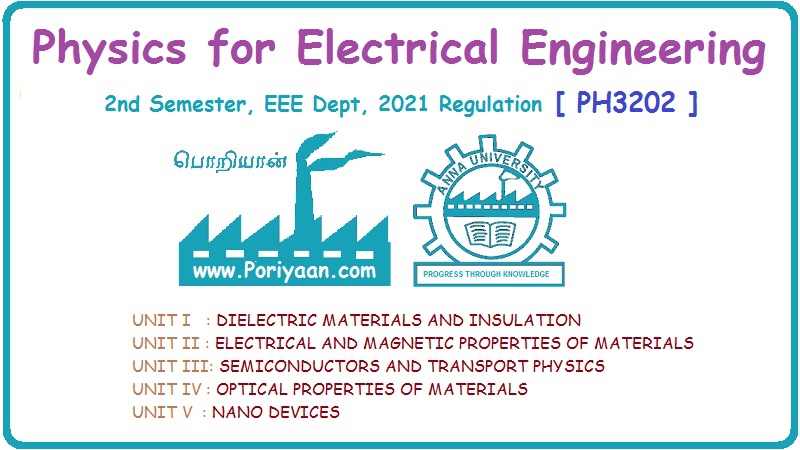Physics for Electrical Engineering: Unit III: Semiconductors and Transport Physics
Anna university solved problems
Semiconductors and Transport Physics | Physics for Electrical Engineering
Physics for Electrical Engineering: Unit III: Semiconductors and Transport Physics : Anna university solved problems
ANNA UNIVERSITY SOLVED PROBLEMS
Carrier
concentration in an intrinsic semiconductor
Problem
3.1
Find
the resistance of an intrinsic germanium rod 1 cm long, 1 mm wide and 1 mm
thick at 300 K.
For
germanium ni = 2.5 × 1019 m-3
µe
= 0.39 m2 V-1s-1
µh
= 0.19 m2 V-1s-1 at 300 K [A.U. Dec. 2014]
Given data
Intrinsic
carrier concentration ni = 2.5 × 1019 m-3
Electron
mobility µe = 0.39 m2 V-1s-1
Hole
mobility μh = 0.19 m2 V-1s-1
1
= length of the rod = 1 cm = 1 × 10- 2m
A
= Area of cross-section (width × thickness)
A
= (1 × 10-3) (1 × 10-3)
Solution
Electrical
conductivity of an intrinsic semiconductor
σ
= nie (μe + μh)
Substituting
given values, we have
σ
= 2.5 × 1019 × 1.6 × 10-19 × (0.39 + 0.19)
σ
= 2.32 Ω-1 m-1

Resistance
of germanium = 4310 Ω.
Extrinsic
semiconductor
Problem
3.2
Find
the concentration of holes and electrons in n-type silicon at 300 k, if the
conductivity is 3 × 104 ohm-1 m-1. Also find
these values for p – type silicon.
Given
data
For
silicon at 300 K, ni = 1.5 × 1016 m-3
µe
= 1300 × 10-4 m2 V-1 s-1
µh
= 500 × 10-4 m2 V-1 s-1
Solution
(a)
Concentration in n-type silicon
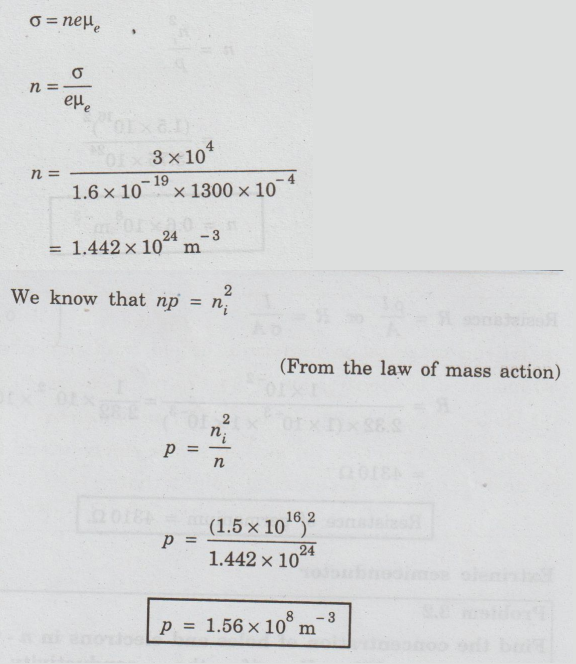
(b) Concentration in p-type silicon
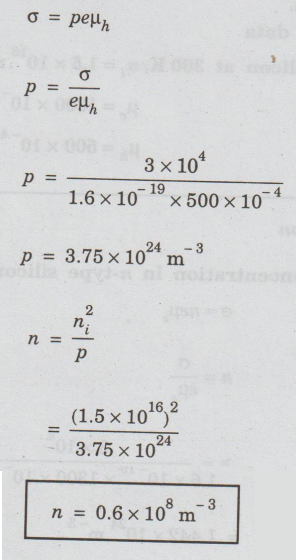
Problem
3.3
A
silicon material is uniformly doped with phosphorus atoms at a concentration of
2 × 1019 m-3. The mobilities of holes and electrons are
0.05 and 0.12 m 0.05 and 0.12 m2 V-1 s-1
respectively, ni = 1.5 × 1016m-3. Find the
electron and hole concentrations and electrical conductivity. (A.U. June 2014)
Solution
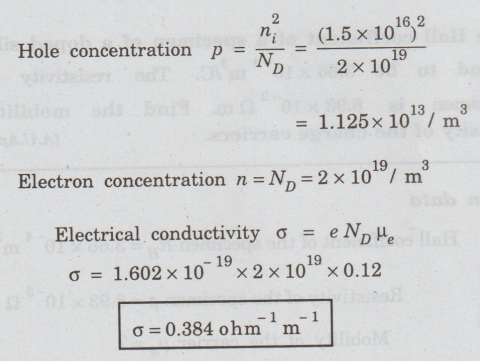
Problem
3.4
Find
the hole and electron concentrations in a p-type semiconductor, if the acceptor
density is 1020 atoms/m3 and the intrinsic concentration
is 2.5 × 1019 per m3 at 300 K. (A.U. May 2016)
Solution
In
a p-type semiconductor, the hole concentration is equal to the acceptor
density.
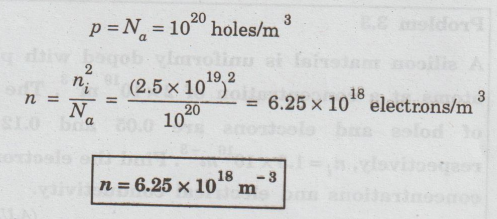
Hall
effect
Problem
3.5
The
Hall coefficient of a specimen of a doped silicon is found to be 3.66 × 10-4
m3/C. The resistivity of the specimen is 8.93 × 10-3 Ωm.
Find the mobility and density of the charge carriers. (A.U.April 2015)
Given
data
Hall
coefficient of the specimen RH = 3.66 × 10-4 m3/C
Resistivity
of the specimen ρ = 8.93 × 10-3 Ωm
Mobility
of the carrier μh = ?
Density
of charge carriers nh = ?
Solution
We
know that density of charge carriers
nh
= 1 / RHe
Substituting
the given values, we have
nh
= 1 / 3.66 × 10-4 × 1.610 × 10-19
nh
= 1.708 × 1022 m-3
µh
= 1 / ρ nhe
µe
= RH / ρ
µh
= 3.66 × 10-4 / 8.93 × 10-3
µh
= 0.041 m2 V-1 s-1
Problem
3.6
Find
the Hall coefficient and electron mobility of germanium for a given sample
(length 1 cm, breadth 5 mm, thickness 1 mm). A current of 5 milliampere flows
from a 1.35 volt supply and develops a Hall voltage of 20 millivolt across the
specimen in a magnetic field of 0.45 Wb/m2. (A.U. May 2013)
Given
data
Current
through the specimen I = 5 mA or 5 × 10-3 A
Voltage
across the specimen V = 1.35 V
Length
of the sample L = 1 cm or 1 × 10-2 m
Breadth
of the sample b = 5 mm or 5 × 10-3 m
Thickness
of the sample t = 1 mm or 1 × 10-3 m
Hall
voltage Vy = 20 × 10-3 V
Magnetic
field H = 0.45 Wb/m2
Solution
:
We
know that resistivity ρ = Ra/l
where
R→ Resistance of the specimen
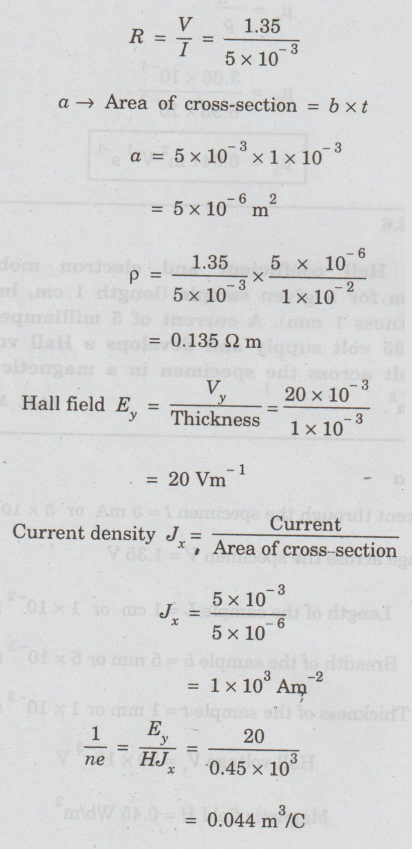
Hall
coefficient
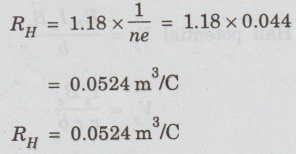
Electron
mobility
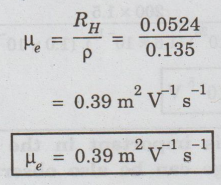
Problem
3.7
A
copper strip 2.0 cm wide and 1.0 mm thick is placed in a magnetic field with B
= 1.5 weber/m perpendicular to the strip. Suppose a current of 200 A is set up
in the strip. What Hall potential difference would appear across the strip?
Given
N = 8.4 × 1028 electrons /m3. (A.U. May 2015)
Given data
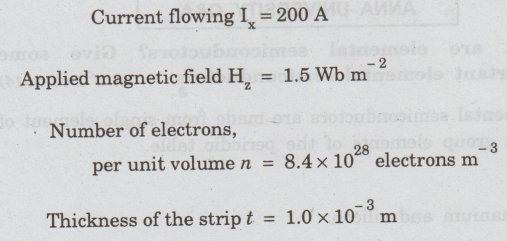
Solution
:
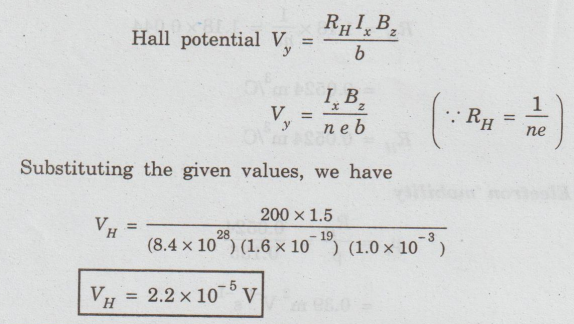
Note: This problem is important
in the sense that it shows that Hall voltage can be also observed in metals
besides semiconductor.
In
semiconductors, Hall voltage is comparatively much larger; it is of the order
of milli-volts as compared to the order of micro-volts in metals.
Moreover,
to observe Hall voltage in metals, current of the order of amperes is needed
when compared to the order of milliamperes as in the case of semiconductors.
Physics for Electrical Engineering: Unit III: Semiconductors and Transport Physics : Tag: : Semiconductors and Transport Physics | Physics for Electrical Engineering - Anna university solved problems
Related Topics
Related Subjects
Physics for Electrical Engineering
PH3202 2nd Semester 2021 Regulation | 2nd Semester EEE Dept 2021 Regulation
